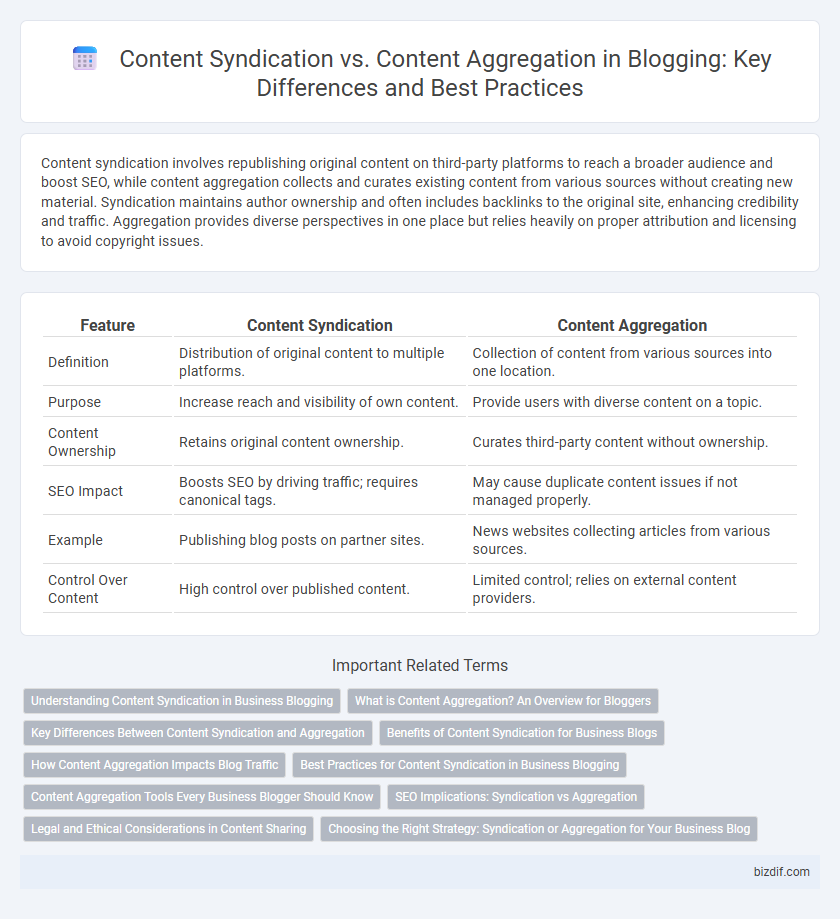Content syndication involves republishing original content on third-party platforms to reach a broader audience and boost SEO, while content aggregation collects and curates existing content from various sources without creating new material. Syndication maintains author ownership and often includes backlinks to the original site, enhancing credibility and traffic. Aggregation provides diverse perspectives in one place but relies heavily on proper attribution and licensing to avoid copyright issues.
Table of Comparison
| Feature | Content Syndication | Content Aggregation |
|---|---|---|
| Definition | Distribution of original content to multiple platforms. | Collection of content from various sources into one location. |
| Purpose | Increase reach and visibility of own content. | Provide users with diverse content on a topic. |
| Content Ownership | Retains original content ownership. | Curates third-party content without ownership. |
| SEO Impact | Boosts SEO by driving traffic; requires canonical tags. | May cause duplicate content issues if not managed properly. |
| Example | Publishing blog posts on partner sites. | News websites collecting articles from various sources. |
| Control Over Content | High control over published content. | Limited control; relies on external content providers. |
Understanding Content Syndication in Business Blogging
Content syndication in business blogging involves republishing original content on third-party platforms to increase reach and drive traffic back to the primary website. This strategy enhances brand visibility, boosts SEO ranking through quality backlinks, and attracts new audiences by leveraging established networks. Understanding content syndication allows businesses to amplify their message efficiently while maintaining content ownership and control.
What is Content Aggregation? An Overview for Bloggers
Content aggregation involves collecting and displaying content from various external sources in one centralized location, allowing bloggers to provide diverse perspectives and curated information for their audience. Unlike content syndication, which redistributes original content to third-party sites, content aggregation pulls published content through feeds or scraping and organizes it under specific topics or niches. For bloggers, leveraging content aggregation can enhance site traffic and user engagement by offering a comprehensive resource hub without creating purely original content.
Key Differences Between Content Syndication and Aggregation
Content syndication involves distributing original content to third-party platforms to expand reach and drive traffic back to the source, while content aggregation collects and curates content from multiple sources into a single location for user convenience. Syndication promotes brand authority and improves SEO by providing backlinks, whereas aggregation primarily serves to offer a comprehensive overview without creating unique content. Understanding these distinctions is crucial for bloggers aiming to enhance visibility or provide curated information effectively.
Benefits of Content Syndication for Business Blogs
Content syndication enhances business blog visibility by distributing original articles across multiple authoritative platforms, driving targeted traffic and improving SEO through quality backlinks. It enables consistent brand messaging and expands reach to new audiences without creating duplicate content penalties. Leveraging syndicated content boosts lead generation and establishes industry authority faster than relying solely on owned channels.
How Content Aggregation Impacts Blog Traffic
Content aggregation consolidates relevant articles and media from multiple sources into one platform, exposing blogs to a wider audience and increasing referral traffic. Unlike original content creation, aggregation leverages existing high-quality content to drive consistent page views and enhance SEO through enriched link profiles. Effective aggregation can boost user engagement by providing diverse perspectives, keeping visitors on the blog longer and improving overall site authority.
Best Practices for Content Syndication in Business Blogging
Content syndication in business blogging involves distributing original content to third-party platforms to increase reach and generate backlinks, enhancing SEO performance. Best practices include selecting relevant and high-authority sites, maintaining canonical tags to avoid duplicate content penalties, and ensuring consistent branding and messaging across syndicated posts. Monitoring traffic and engagement metrics from syndicated content helps refine distribution strategies and maximize return on investment.
Content Aggregation Tools Every Business Blogger Should Know
Content aggregation tools streamline the process of collecting relevant blog posts, news, and updates from multiple sources into one centralized platform, enhancing efficiency for business bloggers. Popular tools like Feedly, Pocket, and Curata enable users to curate industry-specific content, boosting audience engagement and providing inspiration for original posts. Utilizing these platforms helps bloggers maintain a consistent publishing schedule while staying informed of trends and competitor activity.
SEO Implications: Syndication vs Aggregation
Content syndication involves republishing original content on third-party websites with proper canonical tags, which preserves SEO value by attributing the source and avoiding duplicate content penalties. In contrast, content aggregation collects and displays snippets or links from multiple sources, often without substantial original content, which can dilute SEO effectiveness and reduce visibility in search engine rankings. Implementing syndication with structured data and attribution enhances domain authority, whereas aggregation requires careful curation to maintain SEO integrity and prevent content redundancy issues.
Legal and Ethical Considerations in Content Sharing
Content syndication involves the authorized republishing of content with permission, ensuring copyright compliance and often including attribution to the original source, which aligns with ethical blogging practices. Content aggregation, on the other hand, collects content from various sources, sometimes without explicit consent, raising legal risks related to copyright infringement and violating terms of service. Bloggers must prioritize obtaining proper licenses or permissions, provide clear attribution, and respect intellectual property rights to maintain ethical standards and avoid legal disputes in content sharing.
Choosing the Right Strategy: Syndication or Aggregation for Your Business Blog
Content syndication involves republishing your original blog posts on third-party platforms to increase reach and backlink authority, while content aggregation collects and curates relevant industry content from multiple sources to provide added value to readers. Choosing the right strategy depends on your business goals: syndication boosts brand exposure and SEO through broader distribution, whereas aggregation positions your blog as a centralized resource hub with diverse insights. Evaluate factors like audience engagement, content originality, and SEO priorities to determine whether syndication or aggregation will maximize your blog's impact.
Content Syndication vs Content Aggregation Infographic

 bizdif.com
bizdif.com